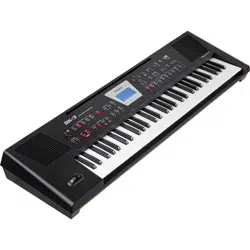Loading ...
Loading ...
Loading ...

Menu options
48
Parameter Setting Explanation
Upper O, On
Select “On” if the “Scale Tune” settings (see
below) should apply to the Upper and
Melody Intell parts.
Lower O, On
Select “On” if the “Scale Tune” settings (see
below) should apply to the Lower part.
Rhythm O, On
Select “On” if the “Scale Tune” settings (see
below) should apply to the rhythm parts.
Scale Tune
This parameter can be selected using [MENU] button
“Performance Edit” “Scale Tune”.
This parameter allows you to change the tuning of all notes of one
octave, which may come in handy to create oriental tunings.
Parameter Setting Explanation
C ~ B
(each note can be set
individually)
-64~0~+63
Changes the pitch of the notes
C~B in steps of 1 cent. The value
that you specify is applied to
all notes of the same name. If
you change the tuning of the
“C”, that value is added to, or
subtracted from, all Cs (C1, C2,
C3, etc.). (“–50” means that the
note in question is tuned a
quarter tone down.)
C note send ~ B note send O, On
• “O”:
The note is not detuned.
• “On” :
The corresponding note is
detuned at the value you
specied (-64~0~+63)
Key
This function allows you to transpose the BK-3’s pitch in semi-tone steps.
Depending on the mode setting, this transposition applies to all sections
or just a specic section.
It can be selected using [MENU] button “Performance Edit” “Key” or by
pressing the [KEY] button. See “Transposing to a Dierent Key” (p. 34) .
TIPS
Pressing and holding the [KEY] button locks this parameter and
keeps it from changing when you select Performance memories.
Key
Allows you to set the desired transposition interval.
Each value represents a semi-tone step. Select “0” if no transposition
is required.
Parameter Setting
Key –6~+5
Mode
Allows you to specify which sections should be transposed by the
“Key” parameter.
Parameter Setting
Mode Song, Keyboard, Song+Keyboard
• “Song”: Only song playback is transposed.
• “Keyboard”: Only the notes you play on the keyboard are
transposed. (This also aects the chord information transmitted
to the Arranger.)
• “Song+Keyboard”: Both song playback and the keyboard parts
are transposed. Rhythm playback is also transposed.
‘Arranger Setting’ parameters
This function group can be selected using [MENU] button “Performance
Edit” “Arranger Setting”.
The parameters of this function group apply to the Arranger as a
whole and allow you to ne-tune its behavior.
Arranger
Select “O” if you only need the drum part of the selected rhythm
and no melodic accompaniment parts (ABass, ACC1~6).
Parameter Setting
Arranger O, On
Zone
When you press the [SPLIT] button, the selected rhythm pattern is
controlled by the chords you play in the left half of the keyboard.
You can also tell the Arranger to scan another part of the keyboard
for usable chords. Though “Left” is probably the most popular
setting, you could select “Right” to have the Arranger scan the right
half of the keyboard.
Switch o the [SPLIT] button if the Arranger should scan the entire
keyboard (“Whole”).
The range of the left and right keyboard areas depends on the “Split
Point” setting (p. 47).
Parameter Setting
Zone O, Right, Left, Whole
Type
Another important choice is how you want to transmit note
information to the Arranger.
Parameter Setting
Type Standard, Pianist1, Pianist2, Intelligent, Easy
• “Standard”: This is the normal chord recognition mode.
• “Pianist1”: In this mode, the BK-3 only recognizes chords that
consist of at least three notes. Playing only two notes will not
cause the rhythm’s key to change.
Loading ...
Loading ...
Loading ...
